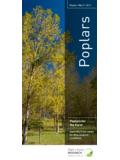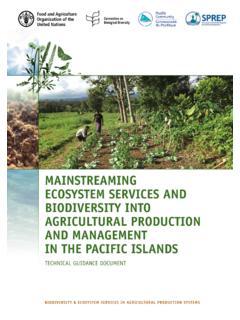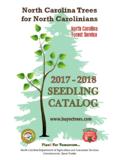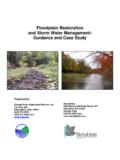Transcription of Trees for the farm - NZ Poplar & Willow Trust
1 Trees for the farm A decision support tool for farmers ContentsDISCLAIMER:Unless agreed otherwise, The New Zealand Institute for Plant & Food Research Limited does not give any prediction, warranty or assurance in relation to the accuracy of or fitness for any particular use or application of, any information or scientific or other result contained in this report. Neither Plant & Food Research nor any of its employees shall be liable for any cost (including legal costs), claim, liability, loss, damage, injury or the like, which may be suffered or incurred as a direct or indirect result of the reliance by any person on any information contained in this report. COPYRIGHT (2017) The New Zealand Institute for Plant & Food Research Ltd, Private Bag 92 169, Auckland Mail Centre, Auckland 1142, New Zealand. All Rights Reserved.
2 No part of this publication may be reproduced, stored in a retrieval system, transmitted, reported, or copied in any form or by any means electronic, mechanical or otherwise without written permission of the copyright owner. Information contained in this publication is confidential and is not to be disclosed in any form to any party without the prior approval in writing of the Chief Executive Officer, The New Zealand Institute for Plant & Food Research Ltd, Private Bag 92 169, Auckland Mail Centre, Auckland 1142, New ZealandIAN MCIVOR | SENIOR A ON- farm ESTABLISHMENT OF Poplar AND Willow TREES2-5 Section B WHY PLANT Trees ON FARMS? A COST-BENEFIT EVALUATION 6-1023 IntroductionThis booklet provides information to farmers who are planting Poplar and Willow Trees on their farms, to assist you in gaining the most benefit for your the first section advice is provided on choosing the most suitable variety, where to plant, how far apart to plant and what useful things can be done to manage the Trees to best advantage.
3 The second section provides some sound economic and environmental reasons why Trees on farms add value. These reasons are often revealed when serious rainstorms hit a ancient Chinese proverb (they are always ancient) says The best time to plant a tree was 20 years ago. The second best time to plant is now .MPI Sustainable Farming Fund contributed to this A ON- farm ESTABLISHMENT OF Poplar AND Willow TREESS paced pole planting on a Trees blocking a slip from covering an access tree DO I PLANT?To protectSLOPESP lant Moutere and Tangoio Willow in the gullies, seek Regional Council advice on choice of Poplar and where up the slope to plant narrow form Poplar , Veronese , Geyles , Kawa , Crowsnest .WATERWAYSP lant a range of species: Pittosporum spp. and other natives, osier Willow and tree willows if bank stability is needed.
4 Osier willows are favoured because they are small and compact and require less planting for summer shade, choose a deciduous tree with spreading branches and leaves that are safe to eat, Poplar , elm, DO I PLANT?SLOPESP lant poles across the slope at spacing of 12 15 m apart with the next row 12 15 m above and two rows of Poplar poles 5 10 m above the track and 8 10 m between poles. Stagger the second row of poles so they provide a maximum barrier to any slip tail from waterways where there are issues with bank stability or gully erosion. Plant tree willows at 10 m spacing with osier willows between. Plant between 1 and 2 m from the water course. Native species can replace osier willows or allow the willows to act as a nurse crop for the natural establishment of natives by close to a holding yard (1 m) where shade is needed, and protect the tree from stock damage.
5 Plant to allow trunk growth, at least 50 cm from the yard rail. Choose a tree with widespread branches, Chinese Poplar , Golden elm, weeping narrow form poplars 4 m apart with either osier willows or another species as a second row on the windward placement Look for the places on unstable ground where soil is sufficiently deep and moist for a pole to establish, and where runoff water will flow towards the managementPOPLARS are naturally leader dominant and are best grown as a single leader. They should be managed by form pruning to protect soil, increase light to pasture and for wood. They can be pollarded but do not yield as much edible fodder as information | Ask your Regional Council about pole planting on Poplars and Willows for farms are available on the New Zealand Poplar & Willow Research Trust website: are naturally multi-stemmed and hard to manage as a single leader.
6 They are best managed by pollarding to protect soil, increase light to pasture and provide supplementary fodder. PLANTING POLES ON HILLSL ocation identify the unstable parts of the slope (tension cracks running through pasture, grassed-over slip scars, grassed mounds and hollows, tunnel gullies, watercourses)SLOPESP lant poles 12 15 m apart with closer spacing where the slope is particularly Pair plant poles up active gullies with each tree opposite its pair at spacings of between 5 6 m down to 2 3 m depending on extent of MANAGEMENT PLAN0 Plant pole, re-ram in early summer3 Reduce to a single leader5 Prune branches to 4 m height using a pole saw9 Prune branches to 6 m height using a pole saw20+Progressively harvest and replant another pole nearbyYEARWILLOW MANAGEMENT PLAN0 Plant pole, re-ram in early at trunk diameter of 28 30 cm by cutting all branches back to a short stump at 2 m above the ground, above cattle grazing the pollarding cycle every 3 4 years.
7 Do not pollard all willows on a slope in the same highly erodible slope planted with planted to stabilise a clonal mixes add feed options and interest to the OF SOIL CONSERVATION TREEST rees have a deeper, stronger, more extensive root system than pasture plants which helps to reduce mass movement mature Poplar or Willow tree (15+ years) protects an area of approximately 300 m2. Trees in a spaced planting are more effective than isolated Trees because of the interconnected root systems (see Figure 2), analogous to steel reinforcing density of 30 50 mature Trees /ha (18 14 m apart) is required for water management, topsoil retention and slope protection over erosion-prone land, while enabling good pasture pasture production/ha in areas with this density of wide-spaced unmanaged Trees is reduced by 8 13% compared with areas with open pasture provided there is no further production on eroded slopes, immediate to long term, is reduced by 20 80% compared with production on un-eroded OF EROSIONOn- farm costs of erosion Repair of infrastructure (tracks, drains, streams, dams, fences, yards and buildings)
8 Reduced nutrient and water storage Reduced pasture production Reduced income from soil productivity loss Increased application of fertilisers to maintain production Reduced property example, direct damage cost $231K on average per farm from the April 2011 storm in Hawke s Bay (43% loss of production, 57% damage to infrastructure).Off- farm costs of erosion Damage to transportation and utility networks Increased sedimentation, reduced water quality, disruption to waterways May be higher than on- farm 2. Root systems of adjacent Trees add reinforcement strength as they mesh B WHY PLANT Trees ON FARMS? A COST-BENEFIT EVALUATION Nationwide costs of soil erosionAgricultural production lossFigure 1. Nationwide costs of soil erosion in New Zealand ($ in 1998, $ in 2008) (after Jones et al. 2008, ).
9 Soil conservation and avoidance measures are effective in reducing agricultural production losses and infrastructure damage. Soil conservation and avoidance measuresOff-site sediment effectsDamage to property and infrastructureWillows stabilising and drying out a slumped OF services FROM WIDE-SPACED TREESP rovisioning services Feed (pasture quantity, quality; tree foliage) Wood Shade and shelter to services Filtering of nutrients and contaminants Flood mitigation Recycling of wastes and detoxification Carbon storage in soil and Trees Regulation of N2O and CH4 emissions Biological control of pests and and regulating services (or benefits) have an economic value. Overall, erosion decreases these values, whereas soil conservation increases them (Figures 3 & 4 on the next page).COSTS OF HAVING WIDE-SPACED TREESI nstallation costs:Planting cost/ha of planting poplars or willows to a high density, and thinning with time 60 poles @ $23 per pole (pole, sleeve, planting) = $1380 per hectarePair plant poles up active gullies with each tree opposite its pair at spacings of between 5 6 m down to 2 3 m depending on extent of instability30 poles @ $23 per pole + 10%= $759 per hectareRe-ramming loose poles (2 hrs @ $50/hr)= $100 Maintenance costs per hectare (based on 60 poles/ha).
10 Reducing to a single leader (varies with the clone) by age 3 years (3 hrs @ $50/hr) = $150 Pruning 60 Trees up to 6m in two lifts by age 9 years (30 hrs @ $50/hr)= $1500 ORPollarding 60 Trees for fodder at age 9 years (30 hrs @ $50/hr) = $1500 Harvesting for fodder every 3 years = $0 (time = fodder value)Harvesting costs:After 20 years; for pruned Trees = $3000; for pollarded Trees = $0 Total costs:Planting cost/ha of planting poplars or willows to a high density and thinning with time. Per hectare over 20 years= $1480 + $1500 + $3000/$0 Any income from sale of wood reduces per hectare per year cost accordingly. Pruning tasks are small and can be done as add-ons to other farm work. Figures are based on 2015 values without informationFigure 3. Relative $ value of feed production and flood mitigation (as examples of ecosystem services ) on a representative hill country block in Southern Hawke s Bay before and after erosion event with wide spaced Trees (Dominati and Mackay 2010).











